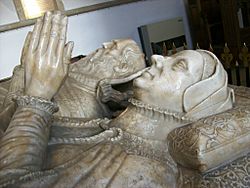John Williams, 1st Baron Williams of Thame facts for kids
Quick facts for kids
The Lord Williams of Thame
|
|
|---|---|

Part of the tomb of Sir John Williams (died 1559) and his wife in St Mary the Virgin, Thame.
|
|
| High Sheriff of Berkshire and Oxfordshire | |
| In office 1538–1539 |
|
| Monarch | Henry VIII |
| Preceded by | Sir Simon Harcourt |
| Succeeded by | Sir Richard Brydges |
| High Sheriff of Berkshire and Oxfordshire | |
| In office 1544–1545 |
|
| Monarch | Henry VIII |
| Preceded by | William Fermor |
| Succeeded by | Sir Humphrey Forster |
| High Sheriff of Berkshire and Oxfordshire | |
| In office 1553–1553 |
|
| Monarch | Mary I |
| Preceded by | Sir Leonard Chamberlain |
| Succeeded by | Sir John Brome |
| Personal details | |
| Born | c. 1500 Burghfield, Berkshire |
| Died | 14 October 1559 (aged 58–59) Ludlow Castle |
| Resting place | St Mary the Virgin, Thame, Oxfordshire 51°45′04″N 0°58′54″W / 51.7511°N 0.9818°W |
| Spouses | Elizabeth Bledlow Margaret Wentworth |
| Children | John Henry Francis Isabel Margery |
John Williams, 1st Baron Williams of Thame (around 1500 – 14 October 1559) was an important person in England during the time of King Henry VIII and his children. He held several key positions, including being in charge of the King's jewels and leading a council for the Welsh border areas. In 1554, he was given the special title of Lord Williams of Thame, which meant he could attend Parliament.
Contents
Who Was John Williams?
John Williams was born around the year 1500 in a place called Burghfield in Berkshire, England. His father was Sir John Williams, and his mother was Elizabeth Moore. His family had roots in Wales. He was also related to some powerful people of his time, including Sir Richard Williams (who was related to Thomas Cromwell, a very important advisor to King Henry VIII). Some people even thought he might be a distant cousin to English monarchs like Edward VI, Mary I, and Elizabeth I.
Working for the King and Queen
John Williams started his career by becoming a receiver for Thame Abbey in 1535. A "receiver" was someone who managed money and property. The head of Thame Abbey, Robert King, was related to him by marriage. In the same year, he got a big job: he became the Treasurer of the King's Jewels, sharing this role with Thomas Cromwell. This meant he was responsible for all the valuable items owned by the King.
The Dissolution of the Monasteries
John Williams played a big part in the "Dissolution of the Monasteries." This was a time when King Henry VIII closed down many monasteries and religious houses across England. The King took their lands and wealth. Williams gained a lot of land and property from this process, including Thame Abbey and a priory in London. He also had a grand palace at Rycote, which was so impressive that King Henry VIII and his wife, Catherine Howard, even visited it during their honeymoon.
Challenges and Royal Favor
Life wasn't always easy for John Williams. In 1541, a fire broke out at his London priory, damaging some of the King's jewels. Later, in 1549, some rebels attacked him and killed deer in his park. Under King Edward VI, he faced some trouble. His financial records were checked, and he was criticized and even put in prison for a short time.
However, his luck changed when Queen Mary I came to the throne. He supported her early on, which made her trust him. Her sister, Queen Elizabeth I, also liked him because he had been kind to her when she was imprisoned. He served as the High Sheriff for Berkshire and Oxfordshire in 1538. A "High Sheriff" was a royal official in charge of law and order in a county.
His Final Years
John Williams passed away at Ludlow Castle on 14 October 1559. His body was brought back to his home at Rycote to lie in state, which means it was displayed with honor. Then, he was buried in Thame Church. Today, only a small part of his stable at Rycote remains, but old drawings show what his grand house looked like.
His Family and Legacy
John Williams was married twice. His first wife was Elizabeth Bledlow, whom he married by 1524. They had three sons named John, Henry, and Francis, and two daughters named Isabel and Margery. After Elizabeth passed away in 1556, he married Margery Wentworth in 1557. She outlived him.
Sadly, all three of John Williams's sons died before him. This meant that when he passed away, his special title, "Baron Williams of Thame," could not be passed on to a son, and so it ended. His daughters, Isabel and Margery, inherited his lands. Isabel received Thame, and Margery received Rycote.
Lord Williams's School
One of John Williams's most important and lasting contributions was founding a school. He left money in his will to create a place of learning for everyone. This school, known as Thame School or Lord Williams's School, was established in Thame, Oxfordshire, in 1559. It started as a "grammar school," which focused on academic subjects. Today, it is a "comprehensive school," meaning it teaches a wide range of subjects to all students. The part of the school where students lived (boarding) closed in 1990.


